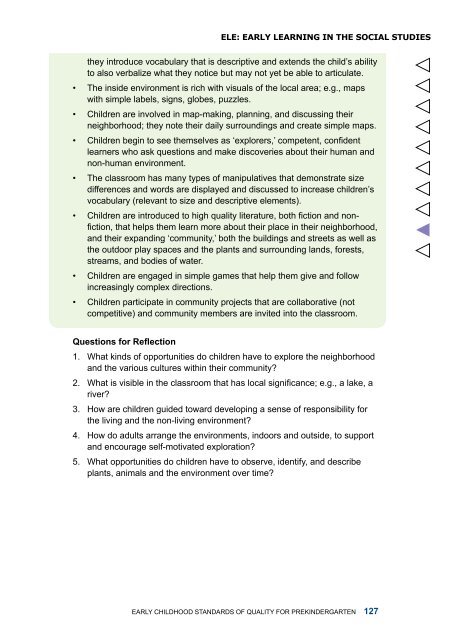Early Childhood Standards of Quality for ... - State of Michigan
Early Childhood Standards of Quality for ... - State of Michigan
Early Childhood Standards of Quality for ... - State of Michigan
You also want an ePaper? Increase the reach of your titles
YUMPU automatically turns print PDFs into web optimized ePapers that Google loves.
ELE: EARLY LEARNING IN THE SOCIAL STUDIESthey introduce vocabulary that is descriptive and extends the child’s abilityto also verbalize what they notice but may not yet be able to articulate.• The inside environment is rich with visuals <strong>of</strong> the local area; e.g., mapswith simple labels, signs, globes, puzzles.• Children are involved in map-making, planning, and discussing theirneighborhood; they note their daily surroundings and create simple maps.• Children begin to see themselves as ‘explorers,’ competent, confidentlearners who ask questions and make discoveries about their human andnon-human environment.• The classroom has many types <strong>of</strong> manipulatives that demonstrate sizedifferences and words are displayed and discussed to increase children’svocabulary (relevant to size and descriptive elements).• Children are introduced to high quality literature, both fiction and nonfiction,that helps them learn more about their place in their neighborhood,and their expanding ‘community,’ both the buildings and streets as well asthe outdoor play spaces and the plants and surrounding lands, <strong>for</strong>ests,streams, and bodies <strong>of</strong> water.• Children are engaged in simple games that help them give and followincreasingly complex directions.• Children participate in community projects that are collaborative (notcompetitive) and community members are invited into the classroom.Questions <strong>for</strong> Reflection1. What kinds <strong>of</strong> opportunities do children have to explore the neighborhoodand the various cultures within their community?2. What is visible in the classroom that has local significance; e.g., a lake, ariver?3. How are children guided toward developing a sense <strong>of</strong> responsibility <strong>for</strong>the living and the non-living environment?4. How do adults arrange the environments, indoors and outside, to supportand encourage self-motivated exploration?5. What opportunities do children have to observe, identify, and describeplants, animals and the environment over time?<strong>Early</strong> <strong>Childhood</strong> <strong>Standards</strong> <strong>of</strong> <strong>Quality</strong> <strong>for</strong> Prekindergarten 127


